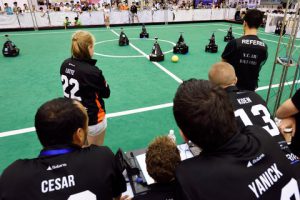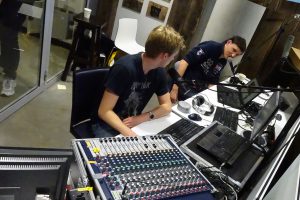Categorie: Home rechts
Tests at 747 kHz AM
Soccer Robots accelerate Autonomous Driving and Medical Surgery

The TU Eindhoven soccer robot team will be defending its world title from 27 to 30 July at the RoboCup in Nagoya, Japan.
Yet this is not only about games and sports competition, it is also pushing the frontiers of innovation in autonomous driving and medical surgery.
Radio4Brainport interviews a big fan of the Robocup and the Tech United team from Eindhoven: Prof. Maarten Steinbuch.
RoboCup is the world championschip for intelligent robots in different disciplines, with almost 4000 participants from 40 countries. If Tech United gets to the final, it will be the tenth time in a row. And if the fully autonomous Eindhoven soccer robots win, it will be their fourth world title. In the ‘help-at-home’ category, the TU/e team hopes its robots will be able to bring home a first world title after second and third places at previous tournaments.
Prof. Maarten Steinbuch te gast in Studio Brainport

Studio Brainport is a weekly program in Dutch that we co-create with Studio040. An English version can be heard in the programs of radio4brainport.org
In de aflevering van deze week was Prof. Maarten Steinbuch te gast. Hij kijkt vooruit over hoe we in de toekomst kunnen leren als je technische feitenkennis rechtstreeks naar ons brein kunt oploaden. Kun je dan inzicht en inventiviteit meteen ook meegeven of blijft het leggen van verbanden tussen feiten en technieken toch een kwestie van eigen ervaring en een echte menselijke gave?
Op Soundcloud hoor je de verkorte podcast versie, met de muziek eruit geknipt.
<iframe width=”100%” height=”450″ scrolling=”no” frameborder=”no” src=”https://w.soundcloud.com/player/?url=https%3A//api.soundcloud.com/tracks/331212855&auto_play=false&hide_related=false&show_comments=true&show_user=true&show_reposts=false&visual=true”></iframe>
“I am not a tourist”: The Expat Event

The “i am not a tourist” Expat Fair Eindhoven is the biggest event for internationals living, working, studying or setting up a business in the South of the Netherlands.
The Expat Fair is a prime opportunity for the international community in the South of the Netherlands to get the low-down on life in the ‘low countries’.
Radio with an instinct

Humans have been exploring the world from the depths of the oceans to the edges of the universe. Yet many environments remain inaccessible, even to modern cutting-edge technology. Therefore problems like exploring the status of waste water under the Fukushima reactor, or discover suitable sites for underground CO2 storage remain unsolved.
Peter Baltus explains how TU/e, RWTH Aachen and KU Leuven study ultra-low power wireless sensor networks. The aim is to investigate a new line of technology that will enable the exploration of difficult-to-access environments exploiting a risky, highly-novel approach called Phoenix.
Phoenix attempts to explore inaccessible environments with physical agents, say small radio nodes, that are extremely limited in size and resources, and can operate without direct control over software and hardware. Phoenix starts with processing a user question, then assesses available knowledge and initiates an evolutionary process involving two nested generational loops. In the outer loop Phoenix develops, deploys and retrieves physical agents capable of penetrating the inaccessible environment and gathering information. Based on this knowledge, a model of the unknown environment is developed and evaluated. This model is refined in the inner loop, where environmental models and abstract representations of the physical agents (virtual agents) co-evolve in a virtual world until an improved generation of physical agents is ready for deployment. The goal of this co-evolution is to maximize the information captured about the unknown environment by progressively optimized agents.
Tussen gigahertz radio en infrarood licht: de wereld van de terahertzen

Electromagnetic waves at frequencies in between radio and infrared light: Terahertz waves offer great new possibilities: ultra high speed radio communication, but also the ability look “through” objects, to detect weapons, explosives, drugs, …. Detecting medical conditions in anon-invasive amnner or even from a distance….. Marion Matters at TU/e explores this exciting field.
Licht kun je beschouwen als radiogolven, maar dan wel van een zeer hoge frequentie, zo hoog dat de eigenschappen als radiogolven niet altijd meer herkenbaar zijn. Maar er zit nog een flink “gat” tussen de hoogste frequentie van de radiogolven die we nu gebruiken en het licht. Maar juist dat onontgonnen stuk van het spectrum, dus tussen Gigahertz radio en infrarood licht in, dat blijkt toch heel interessant. Dat is het domein van de terahertzen.
Met moderne elektronica lukt het maar net om dat soort golven en signalen te maken. Maar de belofte is groot: Het kan worden gebruikt voor extreem snelle radio verbindingen. Maar een even interessante eigenschap is dat allerlei stoffen in resonantie komen bij die terahertzen. En omdat elke molecuulstructuur eigen resonanties heeft kun je complexe stoffen heel precies analyseren. En dat analyseren kan ook op afstand.
Op luchthavens zie je al terahertz scanners, rond draaiende robotarmen in een hokje waar passagiers met armen boven het hoofd in staan om wapens of explosieven te detecteren. Maar er zijn ook toepassingen om door de verpakking heen te scannen hoe vers vlees in de supermarkt is. Of medische toepassingen, om gemakkelijk verschillende medische aandoeningen te herkennen.
De TU Eindhoven werkt hard aan het realiseren van technologie waarmee terahertz signalen kunnen worden gemaakt. Maar ook aan wat je er dan mee kunt doen.
In Studio Brainport, een interview met Marion Matters over de mogelijkheden met terahertzen, op Studio040 in een co-productie met Radio 4 Brainport, zaterdag van 9 tot 10 uur.
You can listen to the English version of the interviews at Radio 4 Brainport.
Brainport Ambassadors
Ton Backx: Brainport as Fotonics Hotspot

Eindhoven, the City of Light in a new perspective: It used to be a city where light bulbs where manufactured, but it may well become the hotspot for smart technology with photons that accelerate communications, improves sensors, etc.
The interview in Dutch will be on Studio Brainport, the English version will be featured at Radio 4 Brainport



